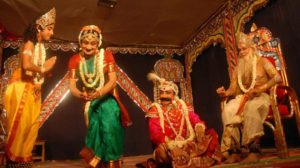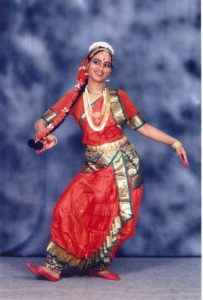Vaachikaabhinaya (vocal communication – through words) is of two kinds – songs/ poems set to a rhythmic cycle (taala) and prose. Kuchupudi, Bhagavatamela and Kathakali have completely adopted Carnatic classical music today. This is even more prominent in Melattur Bhagavatamela. Kuchupdi has retained some special features of the Natya-sangeetha of Andhra. One can observe traces of Sopaana-Sangeetha in Kathakali, but it does not have the regional flavor that the music used in Krishnanaattam has. Koodiyattam seems to have lost out on its vaachikaabhinaya due to the strange music with crude gamakas (musical embellishments) and estranged dialogs that it employs. It is due to this kind of music that the nrtta in Koodiyattam is extremely stylized and fails to appeal aesthetically. These problems do not arise either in Kathakali or Krishnanaatta, as these forms have done away with dialogs altogether. The strength of Kathakali lies in the melody of its songs. Sometimes, however, when the music is slow-paced and the orchestra consists only of percussion instruments such as chande, shuddha-mardalam, chakrataala and jayaghanta, the Rasa (aesthetic experience) is watered down.
[contextly_sidebar id="qy47w3AT4IztxU8DCePpK3osKhT2TNMn"]
Originally, Moodalapaaya, Doddaata and Paduvalapaaya Yakshagana had the same kind of music and there have been some modifications in their styles in recent times. This being so, the efforts of Dasacharya, a Bhagavata (musician, vocal support) for the revival of the original style of Bhaagavatike in Padavalapaaya Yakshagana are laudable. Doddatta has employed Shehnai, Tabala and other instruments of Hindustani music, displaying its keenness in revival of regional flavor. The music used in Ghattadakore and Kelike have remained weak and it is not seeing the light of rejuvenation. Chindu, Maala and Torpu-Yakshagana too have met with the same fate. They lack melodic instruments in their orchestra and rely mainly upon percussion instruments and singing in chorus, which makes the music harsh. This also results in loss of subtleties in treatment of ragas and the emotions associated with it. Terukkuttu too falls into the same category. The excessive use of the harmonium makes the music sound harsh to the ear.
In summary, it looks like we can classify the dance forms into three groups, with decreasing melody in their music. Kuchupudi, Melattur Bhagavatamela, Kathakali, and Krishnanaattam constitute the best group, followed by Moodalapaaya, Doddaata, Kelike and Ghattadakore, with Chindu, Torpu, Maala-Yakshagaana and Terukkuttu bringing up the rear. The element of shrillness in the singing, the harshness and energy in the music seem to increase in the same order. The music used in Padavalupaaya Yakshagaana seems to tread the middle ground here. Traces of melody and mildness in rhythm make their presence felt now and then. Emotions connected with ragas are almost absent. These drawbacks seem to arise mainly due to minimal usage of melody instruments. Moreover, a primary training in classical music is very much required for Bhagavatas (singers). We must nevertheless acknowledge that there is good control of rhythm, good presentation technique, neat employment of muktaayas (ending notes of a rhythmic cycle) and effective usage of Chande, Maddale and vocal music. There are a few Bhagavatas in the Tenkutittu variety of Yakshagana who focus on aesthetic elaboration of raga, but they tend to ignore the intrinsic metrical beauty (Chando-gati) of the songs. In the Badagutittu of Uttara-Kannada, the elaboration of ragas is lesser and the music is slow paced, results in the loss of intrinsic rhythmic melody of songs. In the Badagutittu of Dakshina-Kannada, there is less emphasis on the elaboration of the raga, but their songs appear to be set to a more pleasant rhythm. At another extreme, in the Tulutittu variety of Yakshagana, contemporary themes are portrayed, employing film songs and commercially available popular music. This has reduced the classicality of the style.
The works published by Udupi Yakshagana Kendra and written by Neelavara Ramakrishnayya and Vidwan M. Rajagopalacharya on Yakshagana music serve as guidelines for artists. The Bhagavatike of Vidwan Ganapati Bhatta stands as a good example for aesthetic singing, melodious elaboration of ragas and clarity in pronunciation of lyrics. However, for this to become the mainstream pattern, others too need to put in efforts and get trained. In Tenkutittu, the song-rendition style of Balipanarayana Bhagavata, the catchy presentation style of Padyagana Ganapati Bhatta and the melodic singing of ragas by Dinesh Ammannaya are welcome developments in the field.
In terms of dialog delivery, Kuchupudi has more or less lost the tradition. What remains is the dialogs delivered by the orchestra and the actors do not actively speak. Moreover, the dialogs are scripted and practiced before hand. Krishnanaattam and Kathakali too have this kind of vaachika. The vaachika of Koodiyattam too is scripted and is not delivered extempore like in Paduvalapaaya Yakshagana. In the rest of the art forms such as Doddaata, Moodalapaaya,Ghattada-Kore, Kelike, Chindu, Maala, Torpumelam, Terukkutu, Melatturu Bhagavatamela, the dialogs are written and memorized before-hand. Moreover, these dialogs are also full of unnecessary exaggeration, lack propriety (anauchitya), are weak in content and are plagued by inadequate practice. In Melattur Bhagavatamela most of the actors speak Tamil as their mother tongue, but need to deliver dialogs in Telugu, which forces them to blindly memorize the lines and deliver them without even understanding the meaning.
Of late, Doddaata and Moodalapaaya have regained some discipline in their vaachika. However, Terukkuttu and Chindu do not seem to have cultivated much discipline. The vaachika of Paduvalapaaya Yakshagaana is unmatched in its exuberance. Its excellent vaachika has resulted in the growth of an independent form of performing art, namely, the Taalamaddale, which primarily relies on Bharati-Vrtti (speech and songs). This stands as a testimony for its skill in vaachika. This can also act against the art, because, we have seen the excellence Kathakali and Kuchupudi have attained because of their limited vaachika or a total absence of the same. It is true, nevertheless, that vaachika has its own strength, i.e., to communicate ideas artistically through speech and we can confidently say that there is no other traditional art-form in the world, which is full of erudition and thought-provoking content. However, it would not be wrong to say that excessive attention to vaachika has reduced the sophistication of the naatya-dharmi and attention of saattvika and angika. Thus, one of the main strengths of Paduvalapaaya Yakshagana has also become one of its major drawback. One must be very cautious to strike a balance in these aspects.
Finally, let us take a brief look at Saattvikaabhinaya. It is essentially an aspect of our mind and however hard we may try to describe it using words, we are not likely to succeed. In Kuchupudi Bhagavatamela and Kathakali, there is rich saattvikaabhinaya together with Naatya-dharmi. Kuchupudi Bhagavatamela in particular has a good proportion of Loka-dharmi too. All the art-forms of Kerala, due to extreme stylization and adherence to peculiar traditional texts, tend to portray all aspects of Loka-dharmi through Naatya-dharmi. This has reduced the art to a mere mechanical routine and has turned what is to be of the emotional domain to that of the intellectual domain. Kathakali is better than the rest of the art-forms of Kerala in this respect. The saattvikaabhinaya in Melattur Bhagavatamela is a crude imitation of Sadir, or popular plays and films and Terukuttu borders on the exaggeration of worldly emotions. Even Chindu, Maala and Torpu-Bhagavatamela seem to lack creative saattvikaabhinaya. Although it is not ugly, the saatvikaabhinaya is not captivating and does not provoke wonder. Moodalapaaya, Ghattada-kore, Kelike and other forms too are equally poor in this aspect.
In the Padavalupaaya Yakshagaana, the Tenkutittu variety lacks saattvikaabhinaya. The costumes (aaharya) and the body language (aangika) are also responsible for a rather dull saattvika. The Badagutittu of Dakshina Kannada has neatness and discipline, which brings it closer to emotion mixed saattvika, but still, pure saattvikaabhinaya is lacking. The Badagutittu of Uttara Kannada has a reasonable amount of saattvika, but lacks creativity and propriety (auchitya). They focus more on padaarthaabhinaya (depiction the meanings word-by-word through gesture language) and less on vaakyaarthaabhinaya (elaboration of the whole sentence of the theme through interpretations). One must make sure that the sthaayi-bhaava (predominant sentiment) is well established along with vyabhichaari bhaavas (transitory emotional states) and one must creatively elaborate the sanchaari bhaavas (complementary emotional states). In this regard, the main artists of the Idagunji-mela, many of Purnachandra-mela and the solo Yakshagana productions (eka-vyakti-Yakshagaana) of recent times seem promising.
In summary, when Yakshagana is examined with respect to its allied art-forms, it stands close to their mean. In a few aspects, it is ahead of the rest and in a few, it lags behind. In terms of the non-aesthetic aspects too, such as religion, global recognition, economic status of the artists, social and cultural background, its status in the modern world, etc., we could say that Yakshagana represents the average again. However, there is enough potential for growth and this series of articles has hinted at some possible avenues for improvement. In its totality, Padavalupaaya Yakshagana is indeed a wholesome theatrical treat with large elements of dance in it and can stand as a good model for the same. It is truly the pride of Karnataka and stands as one of the artistic symbols of the state.
Adapted from the original Kannada by Arjun Bharadwaj


















































